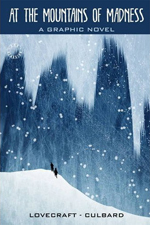‘At The Mountains Of Madness’ – the graphic novel
H.P. Lovecraft. He’ll be the focus of my ‘Lovecraft lore’ blogs of course. While I am no Lovecraft scholar, I am a huge fan. In this installment I want to talk about ‘At The Mountains Of Madness’ graphic novel, adapted by artist I.N.J.Culbard.
The name ‘Lovecraft’ brings to mind tales of horror, particularly (in my opinion) stories that are part of his ‘The Cthulhu Mythos’. These are tales about the ‘Old Ones,’ monstrous gods from another place that ruled the earth eons ago but await for an opportunity to return. ‘At the Mountains of Madness’ is a story by Lovecraft that has all the elements that make the mythos so memorable and haunting.
The 1931 novella ‘At the Mountains of Madness’ recounts the story of a group of scholars and scientists from Miskatonic University. who travel to snowy Antarctica where they stumble upon and awaken the ancient beings who had been frozen there for eons. I won’t bore you with a recount of the entire story, if you haven’t read this one you should.
Now adapting this tale visually, as with most Lovecraft tales is a daunting task. Lovecraft’s descriptions can be vague, usually with an explanation along the line of ‘it’s too much for the human mind to comprehend.’ I. N. J. Culbard is the brave artist who has adapted this tale into a graphic novel format. His style is crisp, clear and cartoony, similar to the European style such as Hergé and Challand. I am a huge fan of these artists, so this approach totally worked for me. Culbard gives all the characters distinct features, so it’s easy to tell them all apart since they all are wearing the same arctic gear through most of the story. He also gets the 1930s time period down with hair and clothes styles as well as planes, ships and items from the day. This skill comes in handy keeping the story visually interesting, especially early on when there is a lot of exposition dialogue.
At the suspenseful climax, Culbard’s art, particularly his layouts and colors, convey a sense of gloom and foreboding as the main characters franticly attempt to flee the bizarre city they’ve stumbled upon. His depiction of the unnatural Shoggoth, is simple yet frightening at the same time.

So I heartily recommend this graphic adaptation, whether you’re a fan of Lovecraft, horror, comic art or all of the above. Since discovering Culbard, I will have to seek out some more of his graphic novel adaptations such as The Sign of the Four (Sherlock Holmes) and The Case of Charles Dexter Ward (available only in Europe right now). I can’t wait to read them!
What are your favorite Lovecraft stories? I’d love to hear from you!













At The Mountain of Madness is easily my favorite of his. I am going to have to check it out. Have you seen the short stop motion animated Call of Cthulhu? It is rad!
No I did not know about that animated film! Link please!
Horror out of Innsmouth is a choice tale. It seems very important story in piecing the mythos together. And plus it places you there better than most, you you feel like you are trapped in Innsmouth, which is scary as hell.
Mike Griffiths
‘Innsmouth’ IS a good one Mike! ‘The Haunter of the Dark’ is my personal favorite among LOTS of favorites! I hope you like my Comic and Site and come back often!! Oh and tell your friends!!